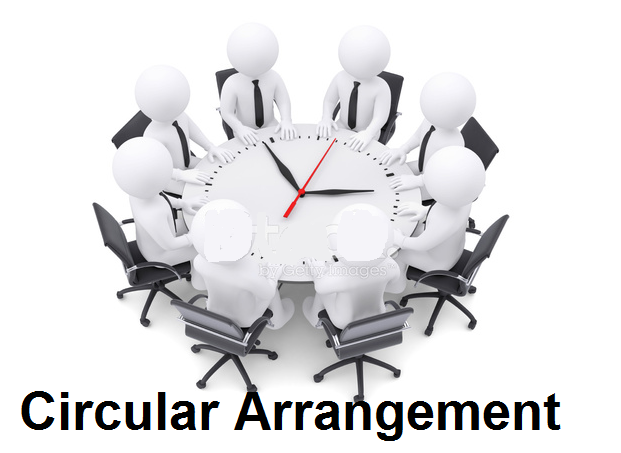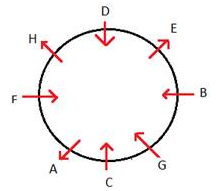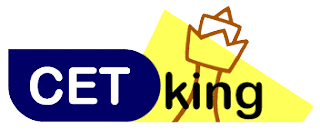Techniques to solve Sitting arrangements reasoning Set 1
So, there you have it dear friends, in puzzles and seating arrangement – nothing beats practice – there are ‘ways or methods’ to solve these sums – but ultimately there is no ‘shortcut’ trick’.

Although I have shared technique to solve “Circular Sitting arrangements” here. We will discuss the ‘ways’ to solve seating arrangement sums as properly as possible!
1. The kinds:
There can be two ways of seating people in a circle (could be a square too – doesn’t make a difference), where people are sitting:-
(i) facing inwards – towards the centre of the circle,
(ii) facing outward – away from the centre of the circle.
2. When facing inwards:
Where all the persons to be arranged face the centre – then
i. all their ‘rights’ is in the anti-clockwise direction,
ii. their ‘lefts’ is in the clockwise direction.
So, when they ask who’s to the left of D, in the above diagram – close your eyes – picture yourself to be D – answer will be A.
If picturing in the head is confusing – take the rough sheet you’ve drawn the diagram on and turn it around! Turn it around so that D is directly in front of you – so you become D and now according to your left/right direction – answer the questions!
Nothing simpler and easier than that!!
Sitting arrangements 2
3. When facing outwards:
Where all the persons to be arranged face the centre – then
i. all their ‘rights’ is in the clockwise direction,
ii. their ‘lefts’ is in the anti-clockwise direction.
Here too, try visualizing yourself in their places to answer – or else turn the papers around.
4. How to seat them:
This is the problem area for most – how to correctly seat Mr. A, B and C!
Sitting arrangements reasoning Set 1
Study the following information and answer the questions given below:
Eight friends A, B, C, D, E, F, G and H are sitting in a circle, but not necessarily in the same order. Four of them are facing outside and four of them are facing the centre.
• E faces outside, both the immediate neighbours of E face the centre. H sits second to the right of E. B sits third to the left of E.
• D faces the centre. Both the immediate neighbours of D face outside.
• G sits second to the left of A B sits third to the right of H
• F is an immediate neighbour of D. C is an immediate neighbour of G.
• D is not an immediate neighbour of B
Question 1: Who sits to the immediate right of E.
a) A b) B c) C d) D e) E
Question 2: Who sits to the immediate left of H.
a) A b) B c) C d) D e) E
Question 3: Who sits to the immediate right of F.
a) A b) B c) C d) D e) E
Question 4: Who sits diagonally opposite of B.
a) A b) B c) C d) D e) E
Question 5: Who sits diagonally opposite of E.
a) A b) B c) C d) D e) E
Question 6: Which of the following is odd man out
a) H b) E c) F d) D e) None of these
Solution:
 Practice all 11 sets of advance level Sitting arrangement questions
Set 1 circular seating arrangement facing outside
Set 2 circular sitting arrangement reasoning tricks
Set 3 circular seating arrangement problems
Set 4 sitting arrangement reasoning bank po shortcuts
Set 5 circular arrangement reasoning tricks
Set 6 reasoning sitting arrangement tips
Set 7 Circular sitting arrangement shortcut tricks
Set 8 how to solve seating arrangement reasoning bank po
Set 9 circular seating arrangement problems with solutions
Set 10 Linear reasoning seating arrangement tricks
Set 11 Linear seating arrangement tricks
Practice all 11 sets of advance level Sitting arrangement questions
Set 1 circular seating arrangement facing outside
Set 2 circular sitting arrangement reasoning tricks
Set 3 circular seating arrangement problems
Set 4 sitting arrangement reasoning bank po shortcuts
Set 5 circular arrangement reasoning tricks
Set 6 reasoning sitting arrangement tips
Set 7 Circular sitting arrangement shortcut tricks
Set 8 how to solve seating arrangement reasoning bank po
Set 9 circular seating arrangement problems with solutions
Set 10 Linear reasoning seating arrangement tricks
Set 11 Linear seating arrangement tricks Although I have shared technique to solve “Circular Sitting arrangements” here. We will discuss the ‘ways’ to solve seating arrangement sums as properly as possible!
1. The kinds:
There can be two ways of seating people in a circle (could be a square too – doesn’t make a difference), where people are sitting:-
(i) facing inwards – towards the centre of the circle,
(ii) facing outward – away from the centre of the circle.
2. When facing inwards:
Where all the persons to be arranged face the centre – then
i. all their ‘rights’ is in the anti-clockwise direction,
ii. their ‘lefts’ is in the clockwise direction.
So, when they ask who’s to the left of D, in the above diagram – close your eyes – picture yourself to be D – answer will be A.
If picturing in the head is confusing – take the rough sheet you’ve drawn the diagram on and turn it around! Turn it around so that D is directly in front of you – so you become D and now according to your left/right direction – answer the questions!
Nothing simpler and easier than that!!
Sitting arrangements 2
3. When facing outwards:
Where all the persons to be arranged face the centre – then
i. all their ‘rights’ is in the clockwise direction,
ii. their ‘lefts’ is in the anti-clockwise direction.
Here too, try visualizing yourself in their places to answer – or else turn the papers around.
4. How to seat them:
This is the problem area for most – how to correctly seat Mr. A, B and C!
Sitting arrangements reasoning Set 1
Study the following information and answer the questions given below:
Eight friends A, B, C, D, E, F, G and H are sitting in a circle, but not necessarily in the same order. Four of them are facing outside and four of them are facing the centre.
• E faces outside, both the immediate neighbours of E face the centre. H sits second to the right of E. B sits third to the left of E.
• D faces the centre. Both the immediate neighbours of D face outside.
• G sits second to the left of A B sits third to the right of H
• F is an immediate neighbour of D. C is an immediate neighbour of G.
• D is not an immediate neighbour of B
Question 1: Who sits to the immediate right of E.
a) A b) B c) C d) D e) E
Question 2: Who sits to the immediate left of H.
a) A b) B c) C d) D e) E
Question 3: Who sits to the immediate right of F.
a) A b) B c) C d) D e) E
Question 4: Who sits diagonally opposite of B.
a) A b) B c) C d) D e) E
Question 5: Who sits diagonally opposite of E.
a) A b) B c) C d) D e) E
Question 6: Which of the following is odd man out
a) H b) E c) F d) D e) None of these
Solution:
Although I have shared technique to solve “Circular Sitting arrangements” here. We will discuss the ‘ways’ to solve seating arrangement sums as properly as possible!
1. The kinds:
There can be two ways of seating people in a circle (could be a square too – doesn’t make a difference), where people are sitting:-
(i) facing inwards – towards the centre of the circle,
(ii) facing outward – away from the centre of the circle.
2. When facing inwards:
Where all the persons to be arranged face the centre – then
i. all their ‘rights’ is in the anti-clockwise direction,
ii. their ‘lefts’ is in the clockwise direction.
So, when they ask who’s to the left of D, in the above diagram – close your eyes – picture yourself to be D – answer will be A.
If picturing in the head is confusing – take the rough sheet you’ve drawn the diagram on and turn it around! Turn it around so that D is directly in front of you – so you become D and now according to your left/right direction – answer the questions!
Nothing simpler and easier than that!!
Sitting arrangements 2
3. When facing outwards:
Where all the persons to be arranged face the centre – then
i. all their ‘rights’ is in the clockwise direction,
ii. their ‘lefts’ is in the anti-clockwise direction.
Here too, try visualizing yourself in their places to answer – or else turn the papers around.
4. How to seat them:
This is the problem area for most – how to correctly seat Mr. A, B and C!
Sitting arrangements reasoning Set 1
Study the following information and answer the questions given below:
Eight friends A, B, C, D, E, F, G and H are sitting in a circle, but not necessarily in the same order. Four of them are facing outside and four of them are facing the centre.
• E faces outside, both the immediate neighbours of E face the centre. H sits second to the right of E. B sits third to the left of E.
• D faces the centre. Both the immediate neighbours of D face outside.
• G sits second to the left of A B sits third to the right of H
• F is an immediate neighbour of D. C is an immediate neighbour of G.
• D is not an immediate neighbour of B
Question 1: Who sits to the immediate right of E.
a) A b) B c) C d) D e) E
Question 2: Who sits to the immediate left of H.
a) A b) B c) C d) D e) E
Question 3: Who sits to the immediate right of F.
a) A b) B c) C d) D e) E
Question 4: Who sits diagonally opposite of B.
a) A b) B c) C d) D e) E
Question 5: Who sits diagonally opposite of E.
a) A b) B c) C d) D e) E
Question 6: Which of the following is odd man out
a) H b) E c) F d) D e) None of these
Solution:
 Practice all 11 sets of advance level Sitting arrangement questions
Set 1 circular seating arrangement facing outside
Set 2 circular sitting arrangement reasoning tricks
Set 3 circular seating arrangement problems
Set 4 sitting arrangement reasoning bank po shortcuts
Set 5 circular arrangement reasoning tricks
Set 6 reasoning sitting arrangement tips
Set 7 Circular sitting arrangement shortcut tricks
Set 8 how to solve seating arrangement reasoning bank po
Set 9 circular seating arrangement problems with solutions
Set 10 Linear reasoning seating arrangement tricks
Set 11 Linear seating arrangement tricks
Practice all 11 sets of advance level Sitting arrangement questions
Set 1 circular seating arrangement facing outside
Set 2 circular sitting arrangement reasoning tricks
Set 3 circular seating arrangement problems
Set 4 sitting arrangement reasoning bank po shortcuts
Set 5 circular arrangement reasoning tricks
Set 6 reasoning sitting arrangement tips
Set 7 Circular sitting arrangement shortcut tricks
Set 8 how to solve seating arrangement reasoning bank po
Set 9 circular seating arrangement problems with solutions
Set 10 Linear reasoning seating arrangement tricks
Set 11 Linear seating arrangement tricks
